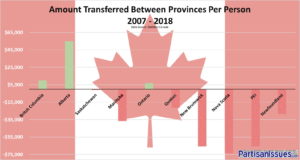

Canada is a group of diverse territories held together with a brilliant formula that effectively transfers money from wealthy Provinces to poor Provinces, or so the story goes. The official name is ‘Equalization Payments’ and they are a core building block of Canadian confederation.
For the first 75 years of Canada’s existence the money was transferred largely at the whim of the Federal Government but in 1957 a formal equalization formula was agreed upon.
Unfortunately, the formula that is used to calculate these payments is opaque and not well understood by citizens, politicians and even academics. This has lead to division and misinformation.
What can be agreed upon on are real numbers from Statistics Canada that show Alberta, Ontario and to a lesser degree British Columbia have been the only source of money for more than 50 years.
In this graph you can see that while Ontario’s contributions to Equalization have dramatically decreased in the last decade, it is still a major contributor. It also shows that even though Alberta has been dealt the largest financial blow of any Province in the last decade, due to a collapse in global oil and gas energy prices, it pays about half of ALL the money paid into the system.
Nobel Laureate, economist James Buchanan presented a talk in October of 2001 that considered Canada’s transfer payment model. It was titled “Equalization: Welfare Trap or Helping Hand”. He concluded that the Canadian model created a culture of dependency that gave the ‘have not’ Provinces little motivation to improve their situation. Indeed, ‘have not’ Provinces have taken the money as if it was some sort of bill to be paid. It is ‘their due’.
Seldom, if ever, is a ‘thank you’ or a ‘we will work harder to contribute more next year’ ever contemplated by the other Provinces. In fairness, this is not the Canadian way. A ‘thank you’ is not required, demanded or even much considered by citizens of Ontario, Alberta and BC. What is expected and repeatedly demanded, is fair access to markets in and through the ‘have not’ Provinces.
Interprovincial and international trade has been a point of anger and debate for decades that has heated up again in the last five years. Ontario wants access Quebec’s construction and liquor markets while Alberta wants energy pipelines to be allows to traverse tiny portions of other Provinces soil. The Energy East and Trans Mountain pipelines are the best examples of such tensions.
The chart also shows that Quebec is and always has been the largest beneficiary of payments but Quebec is a populous Province and so the amount of money sent into Quebec do not tell the whole story.
The table below shows how important Equalization payments are to each Province:
| Province | % of 2017-18 Budget |
| Québec | 9.4% |
| Manitoba | 11.8% |
| Nova Scotia | 15.6% |
| New Brunswick | 18.5% |
| Ontario | 1% |
| Prince Edward Island | 20.6% |
This most interesting chart shows how much money is transferred in or out of each Canadian Province on a per person basis:
While it can be argued that Quebec receives less money per capita than many other small Provinces it cannot be argued who is paying the bill, Alberta, Ontario and BC.
It is important to remember that Alberta has been running deficits for the last decade, which means, they are literally borrowing money at the rate of $483 PER SECOND to give to the reset of Canada:
Albertan’s have paid an average of $55,061 per person into the Canadian Federal Equalization program over the last decade. To be clear, that is $5,500 per Albertan man, women and child every year.
Putting that into a more realistic frame, every working age (18-64) Albertan has paid $8570/year into Equalization for the last decade. They think that should buy Alberta a little good will from the rest of the country. Instead it seems to have only generate jealousy and anger.
.
This website uses cookies.